Grand Finale underway in Ukraine
Russia sees that after May 21, Zelensky is no more the constitutional president of Ukraine but a common citizen. Russia gave an ultimatum, that is an unconditional surrender.
During UN Security Council meeting, April 11, Vasily Nebenzya, the Permanent Representative of Russia to the United Nations, said: “Very soon the only topic for any international meetings on Ukraine will be the unconditional capitulation of the Kiev regime.I advise you all to prepare for this in advance.”

The Bloom | Russian Ultimatum To Zelensky | Capitulation Or Endless War? Military Summary 2024.04.12
It appears that Russia is now after the following Ukrainian cities: Kharkov, Zaporozhye, Sumy, Chernigov, Odessa. Now it is clearly visible in Kharkov that it is being made uninhabitable, as well as ballast for the Ukrainian economy. Next are Sumy and Zaporozhye, where the situation is already difficult. In the third stage are Chernigov and Odessa.
The Kremlin is trying to “kill” the domestic Ukrainian economy, which will provoke a financial disaster in the country. It turns out that the whole country will depend on Western money and the western partners will have to allocate not $3 billion but all 10-15, to support Ukraine, since everything in Ukraine will be in a deep coma. This will hit the pockets of the “sponsors” or provoke a riot in Ukraine against the policies of Zelensky/Ermak.
To hurt Russia’s energy sector, means pain for Ukraine itself and for Europe
Ukraine has been trying to hurt Russia by hitting its refineries. But the attacks have failed to have the desired effects on Russia and the Russian response have been though, in form of de-energization attacks on Ukraine, seriously endangering the state. Large number of energy production plants, stores and distribution systems (electricity, gas, thermal, hydro) were hit.
In response to the Kiev regime’s attempts to damage Russian oil and gas and energy facilities, the Armed Forces of the Russian Federation launched massive strikes on Ukrainian fuel and energy facilities with long-range precision weapons, air-and sea-based weapons, as well as unmanned aerial vehicles. The strike goals have been achieved.
As a result, the work of Ukrainian military industry enterprises was disrupted, the transfer of reserves to combat areas was disrupted, and fuel supply to units and military units of the Armed Forces of Ukraine was hampered.
The US has said that it does not like the Ukrainian strikes on Russian oil facilities because they could lead to an increase in global gasoline prices, which could lower president Biden’s chance for a re-election. US Defense Secretary Lloyd Austin said Ukraine’s recent drone strikes on Russian oil refineries have a “knock-on effect” that could affect the global energy situation and suggested Kyiv focus on “tactical and operational targets” instead. However, unable to provide further money and weapons to Ukraine, the Biden administration has lost much of its leverage over Ukraine.
General Secretary of NATO, usually a spokesperson for US policy, takes a position that is in opposite to what the US Secretary of Defense says: Oil refineries in Russian territory are “legitimate” targets for Ukrainian drone strikes. Stoltenberg reiterated that Ukraine has the right to defend itself by military means.
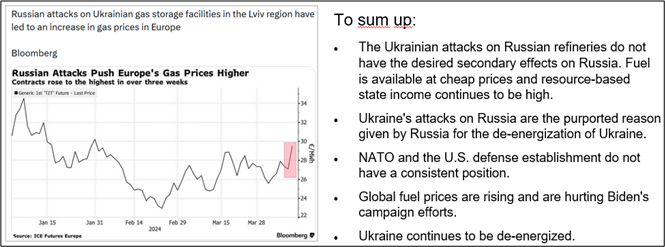
Military actions in frontline and rear areas
Massive Russian strikes have inflicted heavy damage to Ukraine’s energy infrastructure over the last couple of weeks. The ongoing attacks are aimed to complicate the military logistics of the Ukrainian army and prevent its military-industrial complex from launching full-fledged operation. More Russian strikes targeted Ukrainian military facilities. Meanwhile, the Russian army continues pushing all frontlines to the west.

Russia Plunges Ukraine Into Darkness
South Front, April 11, 2024
Ukrainian Front On The Verge Of Collapse
South Front, April 12, 2024
On April 11, Russian forces launched a new wave of devastative strikes throughout Ukrainian rear regions. Explosions thundered in almost all regions from east to west. Targets included large Ukrainian energy and industrial facilities. Russian Geran UAVs were the first to enter the battle in order to distract Ukrainian air defense forces. Then, several strategic missile carriers Tu-95ms and Su-34s launched the missile and glide bomb strikes. Hypersonic Kinzhal missiles were also launched from MiG-31 aircraft.
In 2024, Russian bombs began to reach targets in the city of Kharkiv. The upgrade of Russian heavy bombs has improved the accuracy of such strikes. The bombs are guided by the Russian GLONASS GPS system and are capable of hitting targets at a distance of up to 60 km from the launch site.
Russian warplanes are now able to strike at Ukrainian fortified areas without entering the enemy’s air defense zone. FAB heavy bombs are no longer an ordinary weapon of destruction, but rather a strategic tool capable of delivering highly precise devastating strikes. Russia has been using the FAB-250, FAB-500 and FAB-1500 bombs for a long time, and now the huge FAB-3000 has been added to this list.

New Game Changer: Ukraine Shaking From Russian Heavy Bombs, South Front April 1, 2024
Putin’s Forces Attack Ukraine City Where ‘Foreign Fighters’ Had Arrived, As Per Pro-Russia Group
Hindustan Times , April 4, 2024
The new heavy bombs have been equipped with a universal planning and correction module. The deployment of these three-ton bombs may have a strategic impact on the situations on the front line and will definitely affect the moral of the Armed Forces of Ukraine. The Ukrainian military compares them to tactical nuclear weapons. Despite the destructive power of the FAB-3000, they are allowed by military conventions.
Just a day after a pro-Russia group claimed that foreign mercenaries had arrived in Ukraine, Russian forces launched a severe aerial attack on Ukraine’s second-largest city. The drone strike targeted high-rise apartment buildings and private homes, according to Ukrainian officials. The attack on Kharkiv came after a Russian news outlet told that fighters from countries like France, Poland, and Romania had arrived in Kharkiv and Sumy.
British military expert Alexander Mercouris said that the airstrikes that Russia conducted against the Armed Forces of Ukraine in March were the most powerful attack during the entire period of the special operation. In April, Russian air strikes have continued around Ukraine week after week.
Rus Missile Strike, Tsirkon, 3rd Town Falling, Ukr Troops Bombed, Huge Losses; Neocons Unlimited War , Alexander Mercouris, March 31, 2024.
NATO – Russia relations, in spring 2024
The current state of relations between Russia and NATO can be described as “something more than a Cold War,” the head of Moscow’s delegation at the Vienna talks on military security and arms control, Konstantin Gavrilov, has said. During an interview on April 1, Gavrilov was asked to comment on French President Emmanuel Macron’s February statement that he “cannot exclude” the possibility of troops from NATO countries being sent to Ukraine to aid Kiev. “The military strategists in Washington and Brussels should realize: if by lifting the taboo on the potential deployment of the bloc’s servicemen to Ukraine they are trying to test our country’s strength, then we are ready for any turn of events,” he replied.
His comment echoed Russian President Vladimir Putin’s statement last week that “the claims that we are going to attack Europe after Ukraine – it is utter nonsense and intimidation of their own population just to beat the money out of them.”
The diplomat recalled that Russia has been labeled “the most significant and direct threat” in NATO’s Strategic Concept, which was adopted in 2022. “Apparently, now their ideal vision of European security is the borders with our country being wrapped in barbed wire,” he said. “As a result, Russia-NATO relations can now be characterized as something more than a Cold War,” Gavrilov stressed.
Ukraine Defense Contact Group – Trump proof arrangement
The US and other Western countries are considering transferring to NATO a US-led multinational group that coordinates the shipment of weapons to Ukraine, one of several new proposals that could help maintain the flow of arms to Kyiv under a second Donald Trump presidency.
During the NATO foreign ministerial meeting in Brussels on April 3-4, officials discussed a range of options, including gradually moving the organization — called the Ukraine Defense Contact Group — into the alliance’s control. The goal would be to finalize the move at the NATO leaders’ summit in Washington in July, one of the officials said.
The Ukraine group was launched in the early weeks of the war by Defense Secretary Lloyd Austin and then-Joint Chiefs Chair Gen. Mark Milley to coordinate Western support for Kyiv’s defenses. It’s credited with speeding tens of billions of dollars in equipment, weapons and other aid to Ukraine that have been critical in staving off Russian forces.
Preparing for coming
Manifold preparatory operations and arrangements have been made and are going to be made for coming possible collision between NATO and Russia.
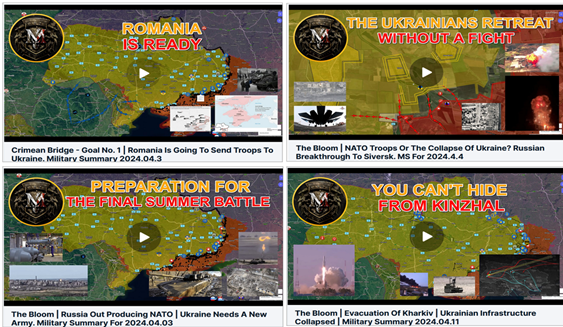
Crimean Bridge – Goal No. 1 | Romania Is Going To Send Troops To Ukraine. Military Summary 2024.04.3
The Bloom | Russia Out Producing NATO | Ukraine Needs A New Army. Military Summary For 2024.04.03
The Bloom | NATO Troops Or The Collapse Of Ukraine? Russian Breakthrough To Siversk. MS For 2024.4.4
The Bloom | Evacuation Of Kharkiv | Ukrainian Infrastructure Collapsed | Military Summary 2024.04.11
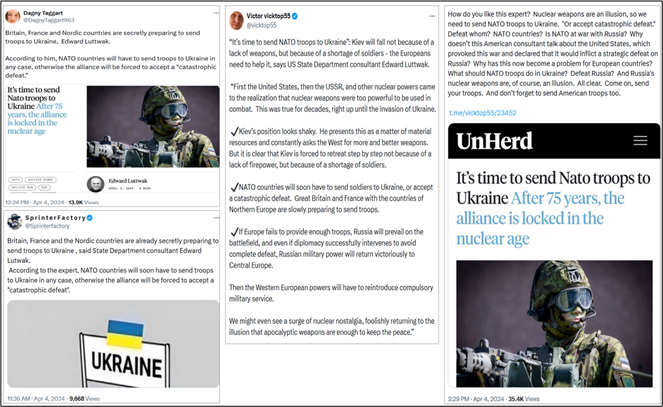
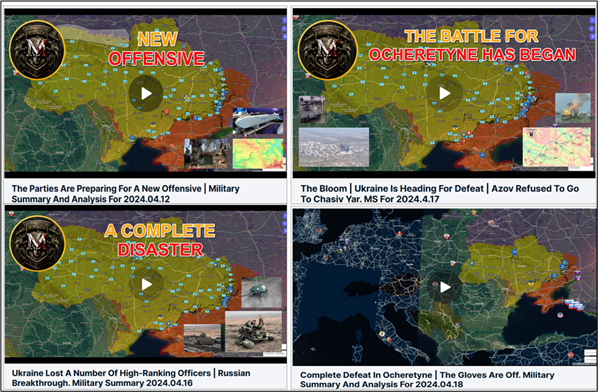
The Parties Are Preparing For A New Offensive | Military Summary And Analysis For 2024.04.12
Ukraine Lost A Number Of High-Ranking Officers | Russian Breakthrough. Military Summary 2024.04.16
The Bloom | Ukraine Is Heading For Defeat | Azov Refused To Go To Chasiv Yar. MS For 2024.4.17
Complete Defeat In Ocheretyne | The Gloves Are Off. Military Summary And Analysis For 2024.04.18
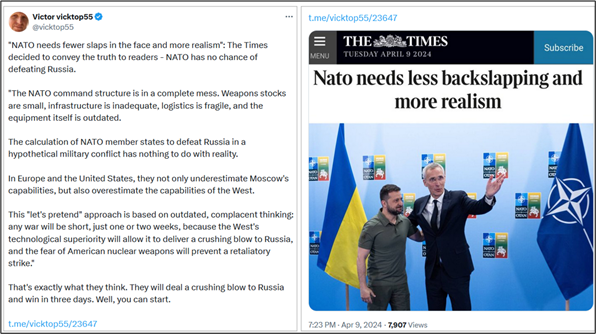
NATO will convene a meeting of the Ukraine-NATO Council on April 19 with the participation of Zelensky – Stoltenberg. The meeting will discuss the supply of air defense systems and shells to Kyiv. NATO countries have a sufficient number of air defense systems that could be transferred to Ukraine – Stoltenberg.
Romania and Moldova
The Romanian army prepares to enter both Moldova and Ukraine. It was in these countries, where the Romanians distributed their passports in large numbers. Romania is preparing a new defense law that will give it a legitimate opportunity to send troops into the territory of other countries to “protect Romanian citizens” in response to “hybrid threats”. In the event of an intervention, all security forces will be mobilized and the National Military Command Center will be created. It will be up to the president to make the decision regarding the intervention. Interestingly, there are only two scenarios, where the Romanian army can enter to protect its citizens.
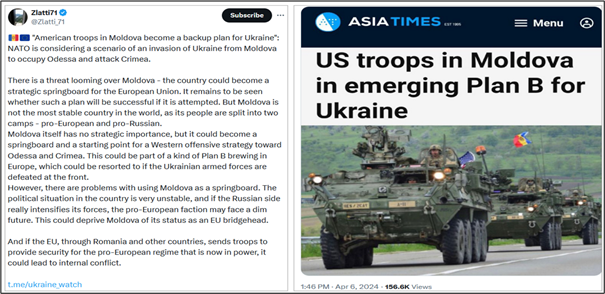
The first one is to Moldova, where more than half a million citizens hold Romanian passports. Romanian Prime Minister Marcel Ciolacu said in an interview with DCNews that he “believes in the union of the Republic of Moldova with Romania.” According to him, the two countries will unite regardless of whether it is going to happen within the EU or in a roundabout way. The reason is simple — protection from Russian aggression. Judging by the Prime Minister’s speech, Washington has given the go-ahead for intervention.
The other scenario will happen regardless of Moldova’s wishes and this will happen, if a second front for Russia needs to be opened. It is obvious that Moscow will be faced with the task of protecting Transnistria and Gagauzia. From Chisinau’s point of view, the leadership of these autonomies is illegitimate for various reasons.
The second option for Romanian intervention will take place in the Chernivtsi region and in the south of the Odessa region, where many (300,000 people) also have Romanian citizenship. Residents of Odessa and Chernivtsi regions may want to choose Russia as their home but not Romania.
Phone call between France/Lecornu – Russia/Shoigu, April 3, 2024
On April 3, the Russian and French defense ministers, Sergei Shoigu and Sébastien Lecornu respectively, spoke via phone, with Shoigu offering talks to end the war in Ukraine and criticizing French plans to send troops to that country. Shoigu also pressed Lecornu about possible French involvement in the March 22 terrorist attack at Crocus City Hall in Moscow. The call had been initiated at France’s urgent request, according to Russian and French reports.
While French and Russian sources gave sharply conflicting accounts of the call, French officials unambiguously rejected Russia’s offer of peace talks. Backed by its NATO allies, Paris is pressing on with plans to send troops to Ukraine that can only lead to war between nuclear-armed states.
After the call, there were conflicting reports on which peace initiative Shoigu meant. Russian sources referred to a proposal for peace talks by Turkish President Recep Tayyip Erdoğan made last month, as Ukrainian President Volodymyr Zelensky visited Turkey. French sources raised the peace deal between Russian and Ukrainian negotiators in Turkey in April 2022, a deal that then-British Prime Minister Boris Johnson forced Ukrainian officials to abandon.
Shoigu also warned Lecornu, according to Russian accounts, that if Paris sent troops to Ukraine, “this would create problems for France itself.”
French military deployment
In mid-April, the first reports from Ukrainian frontlines confirmed deployment of the French military in the Donbass. The first unit of the French Foreign Legion reportedly arrived in the area of the city of Slavayansk in the Donetsk People’s Republic. A unit from the 3rd infantry regiment of the French Foreign Legion, which included about 100 servicemen, has been transferred to the Slavyansk direction before being sent to the frontlines.

More than a hundred French military personnel (from the Foreign Legion) arrived at the location of the 54th separate mechanized brigade of the Ukrainian Armed Forces in Slavyansk. According to other information, 15-20 Caesar self-propelled guns (155-mm) were also delivered there. The unit includes the engineering group and aviation intelligence specialists of the 3rd Infantry Regiment of the Legion. Apparently, this is only the first group of French servicemen deployed in Ukraine, more forces are yet to come. Most likely, these French will take part in building the defense lines around Slavyansk, preparing for the breakthrough in the Donbass front. At the same time, the reconnaissance units are likely to support the Ukrainian military on the frontlines.
In March 2024, SouthFront revealed that the French military was preparing the special battalion tactical group for deployment in Ukraine. This group should include about 1,500 military personnel not only from the members of the Foreign Legion but also servicemen of the Ministry of the Armed Forces of France. The French battalion tactical group should complete combat coordination in mid-April and be ready for deployment abroad. The Foreign Intelligence Service and the Ministry of Foreign Affairs of the Russian Federation officially confirmed the information.
Moreover, on March 18, two first aircraft with French military onboard were spotted landing at Sofia airport in Bulgaria, from where the French servicemen were supposedly transferred through Romania to Odessa.
What is Moscow’s reaction? Perhaps someone should say to Macron that a hundred Frenchmen in Slavyansk do not solve anything. Moreover, thousands of foreign mercenaries have been fighting in Ukraine for two years and more than a third of them have already been sent to another world. However, the arrival of thousands of mercenaries one by one versus at least hundreds of military personnel from a NATO country, are two big differences.
It is obvious that one hundred or even two hundred French in Slavyansk will not change the situation at the front. But this contingent may be followed by a couple of thousand French, who will take control of independent air defense and thereafter tank divisions of France, Germany, Poland and other countries will join the independent one. Then Russia will have no choice but to act in accordance with its military doctrine, that is, to use nuclear weapons, tactical ones for starters.
Perhaps the Kremlin’s first action might be an official request to President Macron about who arrived in Slavyansk and on what basis. If we are talking about some bandits who illegally put on a French uniform, that’s one thing but the official deployment of troops by order of the president is completely different. In the latter option, diplomatic relations will be broken in all countries and in all cases.
But today, we know the Kremlin’s real action, a direct use of heavy bombing. In the night of April 15, a missile strike was launched at the location of French legionnaires in the Slavyansk area. At least dozens of French legionnaires were killed and wounded as well as equipment destroyed.
This in itself was a harsh reply from Russian side but we should not forget that majority of legionnaires are not ethnic French but “consumables” of the French army and in France no one will cry about them.
At the same time, Russia hit many other targets (like Kharkov, Chernigov and others) and number of high-ranking Ukrainian officials (Generals) and up to 80 Ukrainian servicemen have been killed and wounded, possibly among them GRU’s Head Kyrill Budanov himself.
Amid the drastic escalation of dangerous military conflicts, the French president Macron is trying to play the role of global peacekeeper. One of his small goals on the way to saving the world is to stop all wars during the Olympics in Paris. Macron began working on the Olympic truce, asking for help from his “partners”, including China.
Beijing has yet to respond to Macron’s ambitions but Russian President Putin had previously made it clear to his French counterpart: Moscow is ready to consider any peace initiative but would proceed only from its own interests and from the current situation at the front.
Despite all the peace theater of Paris in order to bluff the public, Macron is only pursuing his political goals, while his initiatives, on the contrary, are aimed at influencing the situation on the battlefields. Macron’s peacekeeper game has no chance of helping to resolve Ukraine crisis or any armed conflicts but can only briefly bring solace his French audience.
On April 15, a large explosion thundered in Slavyansk. According to claims from the local guerrilla movement, the precision Russian strike destroyed the location of the Ukrainian gunners, where the French troops also have been stationed.
At the moment, only the training of the French special battalion tactical group consisting of about 1,500 servicemen from the Foreign Legion and regular troops of the French Army have been officially confirmed. Reports on the deployment of the French military on the frontlines can be reliably confirmed, when Paris will no longer be able to hide the obituaries from Ukraine.

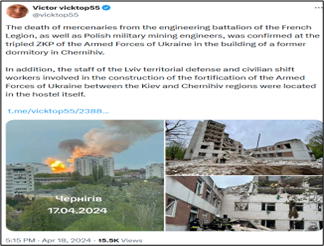
On April 16, Bloomberg reported in an article titled “Macron’s Push to Arm Europe Is Getting More Urgent — and More Dangerous”: the French leader’s problem is that he has not yet achieved the support of French voters in the face of his hardline position to escalate a conflict with Russia by sending French troops to Ukraine. On the contrary, he has attracted the antipathy of some allies, both at home and abroad. Oscillating between peacemaker and provocateur, Macron has shown that he wants to lead the bloc in the Ukraine issue.
While Macron claims to want an end to the Ukrainian conflict, after meeting European leaders at the Palace of Versailles earlier this year, he famously refused to rule out the possibility of sending troops to the ground in Ukraine. However, German and other European allies publicly discarded the idea and thus undermined any ambiguity that had been sown.
Macron’s delusions of grandeur have only deterred many voters from supporting him. Just as importantly, he has isolated himself from the general Western consensus, with the US, Germany, and other major NATO members distancing themselves from his idea to send troops to Ukraine.
Although Macron’s idea has been shunned domestically and by foreign partners, it is a demonstration of how his push to arm Europe is certainly getting more urgent and more dangerous, as Bloomberg warned. This means that Macron is not only becoming more dangerous in his actions but also desperate.
Two prominent videos
Both recent videos explain the causes and progress of the war in Ukraine from different point of view.
The first one, by Going Underground, where speaks Col. Jacques Baud, a former analyst for NATO who was on the ground in Ukraine after the Maidan coup, and author of “The Russian Art of War: How the West Led Ukraine to Defeat”. He discusses his role on the ground in Ukraine and the growth of the Donbas rebellion following the Maidan coup in 2014, the extreme repression of the Russian-speaking regions in Ukraine by the post-coup governments, the failure of the Ukrainian counter-offensive of 2023 and why Ukraine’s tactics continue to fail against Russia’s military strategy, the involvement of the Western militaries in assisting Ukraine in the ground, how Washington’s strategy evolved to weaponize Ukraine to weaken Russia resulting in catastrophe for Ukraine, why the West is at the ‘face-saving’ stage in the proxy war against Russia, UK and French efforts to provoke the US to intervene in Ukraine, and much more.
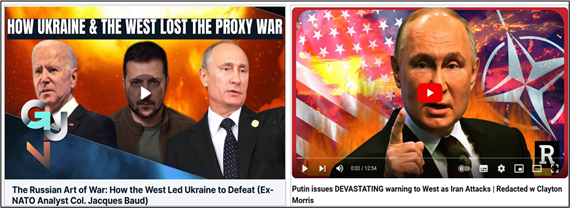
The Russian Art of War: How the West Led Ukraine to Defeat (Ex-NATO Analyst Col. Jacques Baud)
Afshin Rattansi’s Going Underground, April 12, 2024
Putin issues DEVASTATING warning to West as Iran Attacks | Redacted w Clayton Morris
Clayton Morris, April 14, 2024
The second video, by Clayton Morris, tells that Russia just issued two big warnings to the US, one over Ukraine and the other over Iran. Will the Biden administration drag us into a Middle Eastern war? All this turmoil is leading to a surge in gold and oil prices as inflation numbers continue to run hot in the United States. In today’s video, we’re looking at the geo-political chess match playing out that could lead to the demise of the western hegemony.
Ukraine is losing the war – Closing words
When looking at the current political and military situation taking into account the framework of international relations, especially in the global hotspots like Middle East and Taiwan, the timing and characteristics of the Iranian retaliatory strike on Israel are very interesting.
In last five years, the position of Iran has been strengthening significantly, both internally and externally. Iran has considerably developed the armed forces quantitatively and qualitatively as the powerful actor regionally. On the other hand, entering in close and growing cooperation with both China and Russia, Iran has significantly fortified its political position internationally.
The Iranians have been waiting a long time to launch a retaliatory attack on Israel for bombing their consulate in Damascus and also for the assassination of General Soleimani. The characteristics of strike indicated very careful design, planning, targeting and execution. Meanwhile there have been consistent rumors that the Russians are preparing an offensive in Ukraine. Coincidence?
It is well-known that the Russians and Iranians talk frequently, coordinate operations in Syria and share technology. They have deep military-to-military ties and a shared strategic goal of breaking American hegemony and ending the long-term threat to their states from the combination of military containment and civil destabilization favored by American strategists.
It’s far more difficult to move up the timetable for a large ground operation than it is to delay a missile attack. This suggests that – for purely practical reasons if nothing else – the Russians and Iranians are coordinating their operations with each other and that Iran has delayed its big operation against Israel to conform with whatever Russia’s timetable is in Ukraine.
Two huge military crises exploding simultaneously could quite easily overwhelm the decision-making apparatus in Washington and strategically paralyze the United States during the critical hours, days, and weeks ahead. Moreover, who knows what else the other possible international players have in mind, namely China, North Korea and others.
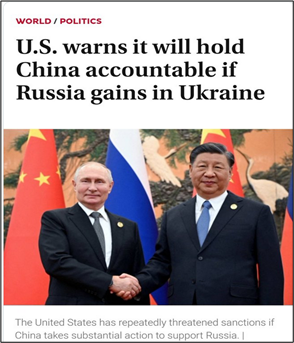
The United States warned recently that it will hold China responsible, if Moscow makes gains in Ukraine, after Beijing renewed pledges of cooperation during a visit by Russia’s top diplomat Sergei Lavrov.
Kurt Campbell, the US deputy secretary of state, said that for the US, maintaining peace and stability in Europe is “our most important mission historically.” With Moscow renewing its Ukraine offensive amid a deadlock in the US Congress on approving more weapons to Ukraine, Campbell warned that Russian territorial gains could “alter the balance of power in Europe in ways that are, frankly, unacceptable.”
“We have told China directly, if this continues, it will have an impact on the US-China relationship. We will not sit by and say everything is fine,” Campbell said. “We will see this not as just a Russian unique set of activities but a conjoined set of activities backed by China but also North Korea. Now it is obvious, why the US is escalating in the South China Sea, pushing on the Philippines to provoke a conflict with China.

Ukraine will not have a chance to win the war without the significant help of the USA. Currently, the ratio of artillery at the front is 1 to 10 and for aircraft it is 1 to 30. With such statistics, the Russian Forces will push AFU back to the Dnieper River. Ukraine has nearly completely run out of AD missiles.
Ukraine holds a disadvantage in every aspect of war, from manpower to heavy vehicles and air defenses. We are witnessing the Ukrainian army transitioning from modern weaponry to a guerrilla force, whose main weapon is civilian drones. This is occurring under the watch of NATO countries and amidst the largest military budget in history.
What can the NATO allies send to Ukraine that would change the course of this war?
I do not see any viable options that could alter the direction of this conflict. The West lacks the mobile air defense systems required by Zelensky and they cannot produce enough missiles to support the long and medium range air defense systems throughout the country. Similarly, regarding artillery pieces, the logistics for maintaining equipment have not been established, not to mention ammunitions.
In this guerrilla warfare armed with FPV drones, the Ukrainians are successfully delaying the Russian advance but without any prospect of victory, it is merely buying time in a losing battle. The new defensive lines built by Ukraine are part of this delay strategy, which will eventually require Zelensky to sit down and negotiate.
For one and half year, I have been predicting a Ukrainian defeat based on parties’ capabilities and multiple shortages. I presented scenarios for the result of the war on April 1 and that 3. realist scenario is still valid.
Two recent statements by prominent Americans:
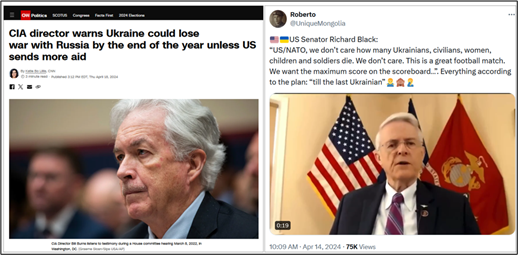
These statements are revealing. It’s not the US Congress or Senate, who are delaying weapons and aid. The entire logic of this war is at odds and the US policy “this is a good investment … fighting till the last Ukrainian” is more than illustrative example of American cynical and hypocritical attitude. Negotiations are not a choice but the only way out, when you have no choices, as is in the case of Ukraine.
ANYWAY, THE END IS NEAR IN SPECIAL MILITARY OPERATION.


